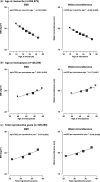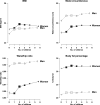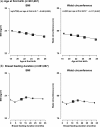Adiposity in relation to age at menarche and other reproductive factors among 300 000 Chinese women: findings from China Kadoorie Biobank study
- PMID: 27524817
- PMCID: PMC5837303
- DOI: 10.1093/ije/dyw165
Adiposity in relation to age at menarche and other reproductive factors among 300 000 Chinese women: findings from China Kadoorie Biobank study
Abstract
Background: Adiposity is increasing rapidly in China but little is known about the relevance to it of women's reproductive factors, which differ inter-generationally and from that in the West. We assess associations of adiposity with life-course reproductive factors in Chinese women.
Methods: In 2004-08, the nationwide China Kadoorie Biobank recruited 303 000 women aged 30-79 (mean 50) years from 10 diverse regions. Multivariable linear regression was used to examine associations of reproductive factors (e.g. age at menarche/first birth/menopause, parity, breastfeeding and reproductive years) with measures of general [e.g. body mass index (BMI)] and central [e.g. waist circumference (WC)] adiposity in adulthood.
Results: Overall, the mean BMI was 23.7 (standard deviation 3.3) kg/m 2 , mean age at menarche was 15 (2) years and nearly all had given birth (99%) and breastfed children (98%). Adiposity was associated inversely with age at menarche and at first birth, with 0.19 and 0.05 kg/m 2 lower BMI and 0.38 and 0.12 cm lower WC per 1-year delay respectively ( P < 0.001). Among 128 259 post-menopausal women, adiposity was associated positively with age at menopause and reproductive years, with 0.05 and 0.07 kg/m 2 higher BMI and 0.12 and 0.17 cm higher WC per 1-year increase, respectively ( P < 0.001). The proportion with overweight/obesity had similar associations with these reproductive factors. Adiposity had a non-linear positive association with parity, but no association with breastfeeding duration.
Conclusion: Among Chinese women, earlier age at menarche and at first birth, later age at menopause and longer reproductive years were independently associated with increased adiposity late in life.
Keywords: Chinese; adiposity; cross-sectional studies; reproductive factors; women.
© The Author 2016. Published by Oxford University Press on behalf of the International Epidemiological Association
Figures




Similar articles
-
The relationship of reproductive factors with adiposity and body shape indices changes overtime: findings from a community-based study.J Transl Med. 2023 Feb 22;21(1):137. doi: 10.1186/s12967-023-04000-1. J Transl Med. 2023. PMID: 36814308 Free PMC article.
-
Women's reproductive health factors and body adiposity: findings from the UK Biobank.Int J Obes (Lond). 2016 May;40(5):803-8. doi: 10.1038/ijo.2015.254. Epub 2015 Dec 24. Int J Obes (Lond). 2016. PMID: 26700411
-
The association between reproductive history and abdominal adipose tissue among postmenopausal women: results from the Women's Health Initiative.Hum Reprod. 2024 Aug 1;39(8):1804-1815. doi: 10.1093/humrep/deae118. Hum Reprod. 2024. PMID: 38890130 Free PMC article.
-
Temporal trends of main reproductive characteristics in ten urban and rural regions of China: the China Kadoorie biobank study of 300 000 women.Int J Epidemiol. 2014 Aug;43(4):1252-62. doi: 10.1093/ije/dyu035. Epub 2014 Mar 17. Int J Epidemiol. 2014. PMID: 24639443 Free PMC article.
-
Early life circumstances and their impact on menarche and menopause.Womens Health (Lond). 2009 Mar;5(2):175-90. doi: 10.2217/17455057.5.2.175. Womens Health (Lond). 2009. PMID: 19245355 Free PMC article. Review.
Cited by
-
The relationship of reproductive factors with adiposity and body shape indices changes overtime: findings from a community-based study.J Transl Med. 2023 Feb 22;21(1):137. doi: 10.1186/s12967-023-04000-1. J Transl Med. 2023. PMID: 36814308 Free PMC article.
-
Breastfeeding and the Risk of Maternal Cardiovascular Disease: A Prospective Study of 300 000 Chinese Women.J Am Heart Assoc. 2017 Jun 21;6(6):e006081. doi: 10.1161/JAHA.117.006081. J Am Heart Assoc. 2017. PMID: 28637778 Free PMC article.
-
Age at Menarche and Cardiometabolic Health: A Sibling Analysis in the Scottish Family Health Study.J Am Heart Assoc. 2018 Feb 10;7(4):e007780. doi: 10.1161/JAHA.117.007780. J Am Heart Assoc. 2018. PMID: 29440004 Free PMC article.
-
Prevalence and risk factors of thyroid nodules in breast cancer women with different clinicopathological characteristics: a cross-sectional study.Clin Transl Oncol. 2024 Sep;26(9):2380-2387. doi: 10.1007/s12094-024-03488-3. Epub 2024 Apr 12. Clin Transl Oncol. 2024. PMID: 38609703
-
Association of age at menarche with valvular heart disease: An analysis based on electronic health record (CREAT2109).Front Cardiovasc Med. 2023 Apr 17;10:1029456. doi: 10.3389/fcvm.2023.1029456. eCollection 2023. Front Cardiovasc Med. 2023. PMID: 37139127 Free PMC article.
References
-
- Lakshman R, Forouhi NG, Sharp SJ et al. . Early age at menarche associated with cardiovascular disease and mortality. J Clin Endocrinol Metab 2009;94:4953–60. - PubMed
-
- Prentice P, Viner RM. Pubertal timing and adult obesity and cardiometabolic risk in women and men: a systematic review and meta-analysis. Int J Obes 2013;37:1036–43. - PubMed
-
- Akahoshi M, Soda M, Nakashima E et al. . The effects of body mass index on age at menopause. Int J Obes Relat Metab Disord 2002;26:961–8. - PubMed
Publication types
MeSH terms
Grants and funding
LinkOut - more resources
Full Text Sources
Other Literature Sources
Medical

